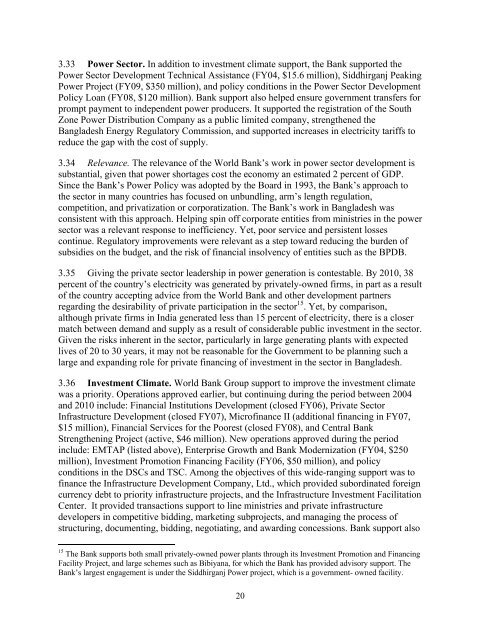Bangladesh - Independent Evaluation Group - World Bank
Bangladesh - Independent Evaluation Group - World Bank
Bangladesh - Independent Evaluation Group - World Bank
You also want an ePaper? Increase the reach of your titles
YUMPU automatically turns print PDFs into web optimized ePapers that Google loves.
3.33 Power Sector. In addition to investment climate support, the <strong>Bank</strong> supported the<br />
Power Sector Development Technical Assistance (FY04, $15.6 million), Siddhirganj Peaking<br />
Power Project (FY09, $350 million), and policy conditions in the Power Sector Development<br />
Policy Loan (FY08, $120 million). <strong>Bank</strong> support also helped ensure government transfers for<br />
prompt payment to independent power producers. It supported the registration of the South<br />
Zone Power Distribution Company as a public limited company, strengthened the<br />
<strong>Bangladesh</strong> Energy Regulatory Commission, and supported increases in electricity tariffs to<br />
reduce the gap with the cost of supply.<br />
3.34 Relevance. The relevance of the <strong>World</strong> <strong>Bank</strong>’s work in power sector development is<br />
substantial, given that power shortages cost the economy an estimated 2 percent of GDP.<br />
Since the <strong>Bank</strong>’s Power Policy was adopted by the Board in 1993, the <strong>Bank</strong>’s approach to<br />
the sector in many countries has focused on unbundling, arm’s length regulation,<br />
competition, and privatization or corporatization. The <strong>Bank</strong>’s work in <strong>Bangladesh</strong> was<br />
consistent with this approach. Helping spin off corporate entities from ministries in the power<br />
sector was a relevant response to inefficiency. Yet, poor service and persistent losses<br />
continue. Regulatory improvements were relevant as a step toward reducing the burden of<br />
subsidies on the budget, and the risk of financial insolvency of entities such as the BPDB.<br />
3.35 Giving the private sector leadership in power generation is contestable. By 2010, 38<br />
percent of the country’s electricity was generated by privately-owned firms, in part as a result<br />
of the country accepting advice from the <strong>World</strong> <strong>Bank</strong> and other development partners<br />
regarding the desirability of private participation in the sector 15 . Yet, by comparison,<br />
although private firms in India generated less than 15 percent of electricity, there is a closer<br />
match between demand and supply as a result of considerable public investment in the sector.<br />
Given the risks inherent in the sector, particularly in large generating plants with expected<br />
lives of 20 to 30 years, it may not be reasonable for the Government to be planning such a<br />
large and expanding role for private financing of investment in the sector in <strong>Bangladesh</strong>.<br />
3.36 Investment Climate. <strong>World</strong> <strong>Bank</strong> <strong>Group</strong> support to improve the investment climate<br />
was a priority. Operations approved earlier, but continuing during the period between 2004<br />
and 2010 include: Financial Institutions Development (closed FY06), Private Sector<br />
Infrastructure Development (closed FY07), Microfinance II (additional financing in FY07,<br />
$15 million), Financial Services for the Poorest (closed FY08), and Central <strong>Bank</strong><br />
Strengthening Project (active, $46 million). New operations approved during the period<br />
include: EMTAP (listed above), Enterprise Growth and <strong>Bank</strong> Modernization (FY04, $250<br />
million), Investment Promotion Financing Facility (FY06, $50 million), and policy<br />
conditions in the DSCs and TSC. Among the objectives of this wide-ranging support was to<br />
finance the Infrastructure Development Company, Ltd., which provided subordinated foreign<br />
currency debt to priority infrastructure projects, and the Infrastructure Investment Facilitation<br />
Center. It provided transactions support to line ministries and private infrastructure<br />
developers in competitive bidding, marketing subprojects, and managing the process of<br />
structuring, documenting, bidding, negotiating, and awarding concessions. <strong>Bank</strong> support also<br />
15 The <strong>Bank</strong> supports both small privately-owned power plants through its Investment Promotion and Financing<br />
Facility Project, and large schemes such as Bibiyana, for which the <strong>Bank</strong> has provided advisory support. The<br />
<strong>Bank</strong>’s largest engagement is under the Siddhirganj Power project, which is a government- owned facility.<br />
20

















